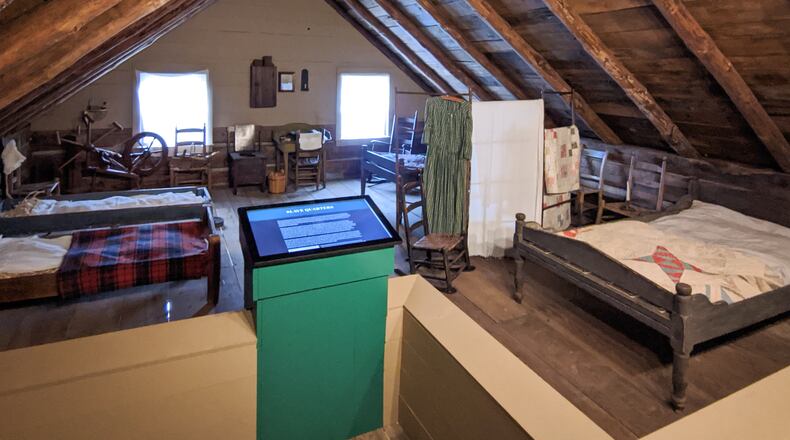The 1840s William Root House in Marietta has received recognition from the Georgia Association of Museums, following an extensive renovation and expansion project that cost about $500,000, according to a news release.
On April 28, the state association recognized the Root House Museum for excellence in exhibition theory, planning and implementation.
The recognition specifically commends the use of touchscreen technology and also recognized the interpretation of the slave experience on the property.
“This award validates the important work Cobb Landmarks is doing at the Root House,” said Trevor Beemon, the museum’s executive director since 2014.
“It also reassures us that the use of technology in a historic house setting can be a successful way to provide information to contemporary visitors who have come to expect this type of presentation in a museum,” Beemon noted.
One of the oldest homes in the Atlanta area, the Root House originally was the home of early Cobb County settlers Hannah and William Root from 1845 to 1886.
The house and property have been restored to their circa 1860 appearance.
Visitor hours are 10 a.m. to 4 p.m. Wednesdays through Saturdays at 80 N. Marietta Parkway NW, Marietta near the Marietta Square, with ticket prices from $7 to $9.
Threatened by demolition in the 1980s, the house was moved in 1990 by Cobb Landmarks & Historical Society and renovated for use as a house museum, depicting middle-class life in Antebellum Georgia.
Since rescuing and restoring the house 30 years ago, Cobb Landmarks has been successful in attracting thousands of visitors to the museum every year.
Beemon introduced a variety of new programs and events designed to help reinvigorate the site.
Between 2013 and 2016, visitation numbers increased more than 300 percent.
However, a lack of space limited the types of programs and number of visitors the museum was able to accommodate.
By the end of 2016, the decision was made to enlarge the Root House campus to better serve visitors.
Around that same time, Cobb Landmarks was approached by the Manning family about donating an 1830s log cabin to the organization.
Originally located on Macland Road in Cobb County, the log cabin was occupied by the Manning family during the 1860s.
Still owned by Manning family descendants in 2018, the family wished that the cabin could be preserved for future generations by donating the cabin to Cobb Landmarks, requiring that it be removed from their property.
A plan to relocate the cabin to the Root House began to form, but the organization needed more land.
The property occupied by the William Root House is leased to Cobb Landmarks, a private nonprofit, from the city of Marietta.
In November 2016, Cobb Landmarks presented a request to the city of Marietta for an additional .082 acres next to the Root House.
The space would be occupied by the Manning Cabin, adding a new Visitor Center with event, exhibit and office space inside.
This request was approved and finalized at a City Council Meeting in December 2016.
With additional land secured, plans moved forward in 2017 when Cobb Landmarks launched a capital campaign for the project titled “The Next Generation.”
For the concept plan, Cobb Landmarks turned to the award-winning architectural firm Historical Concepts.
The work of Historical Concepts has been featured in national publications as a designer of custom homes for clients across the nation and multiple Idea Houses for Southern Living and Coastal Living.
Historical Concepts also has provided master planning for redevelopment in historic Georgia communities like Senoia, Fairburn and Fayetteville.
“As an architectural firm that studies historic precedent to inform our designs, we were intrigued by this vision to bridge past, present and future,” said Historic Concepts’ Ryan Yurcaba about The Next Generation project.
“We are honored to work with the forward-thinking team at Cobb Landmarks to ensure a purposeful future for an increasingly rare trace of Cobb County’s architectural vernacular heritage,” Yurcaba added.
Due to funding by individuals, Cobb Landmarks members, foundations and sponsors, the Manning Cabin was moved to the Root House campus in September 2018.
Plans for the new structure were completed by Olah Design Group, and Fortress Builders oversaw construction.
Freedman Engineering Group provided engineering services.
In addition to the new Visitor Center, The Next Generation project included remodeling and expanding the exhibits at the Root House, with a new exhibit space dedicated to examining the lives of Marietta’s enslaved population.
Interactive touchscreen displays also were installed in each room of the house, giving visitors the opportunity to examine family photos and documents and watch educational videos produced exclusively for the Root House.
Since 1990, the Master Gardener Volunteers of Cobb County have managed the Root House gardens as one of their many, varied gardening projects, spending countless hours each year working in the Root House gardens to demonstrate to visitors the importance of heirloom gardening.
The Master Gardener Volunteers of Cobb County (MGVOCC) support the University of Georgia Cooperative Extension Service and strive to improve the quality of life in the Cobb community by delivering research-based horticultural information, educational programs and projects.
Information: 770-426-4982 or RootHouseMuseum.com
About the Author
Keep Reading
The Latest
Featured


